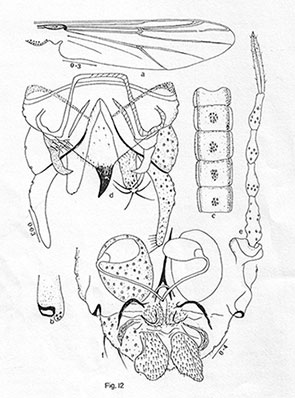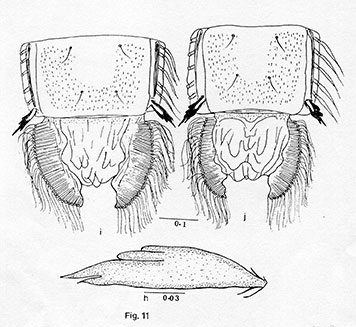Chironomus incertipenis Chaudhuri & Das 1996Other names probably incorrectly attributed to C. incertipennis (lacking dark anal point): Chironomus species 1 Sharma et al. 1990 Chironomus plumosus form A Tripathi et al. 2002 Chironomus plumosus form B Sharma et al. 2004. All morphology from Chaudhuri, Das & Sublette 1992. Many of the measurements seem unrealistic to be millimetres, as claimed. Adult Body length 5.68-6.32 mm; Wing length 2.34 (1.96-2.40) mm; Wing width 0.78 (0.68-0.82) mm., VR 1.01 (1.00-1.03). Head: Vertex with 18 setae. Frontal tubercles well developed Clypeus with 28 setae. Relative length of palpomeres: 7 : 6 : 22 : 25 : 31. Thorax yellow with 3 dark brown vittae. Setae: Acrostichal - 17 biserial; dorsocentral - 24 biserial; prealar - 4; supraalar - 1; Scutellar - 26-28. Legs with femora, tibia and tarsomeres 1-3 yellow, but tarsomeres with dark apex and tarsomeres 4 and 5 brown. Leg proportions and ratios (units not stated):
Abdomen yellowish, tergites II-V with brown oval median spot. About 8-14 setae on tergite IX. SV appears to be a D-type, but may have a beak like some members of the C. samoensis group. Anal point dark brown and widest at base - a diagnostic characteristic.  Adult characters of C. incertipenis from Chaudhuri et al. (1992) (as C. niger) Body length 5.75 (5.61-5.98) mm; Wing length 2.79 (2.89-2.87) mm, width 0.99 (0.96-1.06) mm. Antennal segments in the ratio 8 : 5 : 5 : 6 : 11; AR - 0.46; A5/A1 - 1.38 Genocoxapodeme VIII ovoid, Goxosternapodeme well developed and bow shaped. Gonapophysis VIII divided into an elongated dorsomesal lobe and a stout ventrolateral lobe, apodeme lobe prominent. Postgenital plate broad. TX a narrow crescent; Cerci stout and finely setose, margins curved and possibly a basal bulge on ventral margin. Pupa:Exuviae grey. Length 6.22-6.62 mm (fem.); 6.98-8.04 mm (male). Frontal tubercles 0.06-0.08 mm long and 0.080-0.087 in diameter at base.  Pupal characters of C. incertipenis from Chaudhuri et al. (1992) (as C. niger) Fourth instar larva: A plumosus-type larva, 6.25-12.64 mm long. Gula and frontoclypeus apparently not darkened. Ventral tubules illustrated as about the same length, anal tubules as long and narrow, about 3.5 times longer than wide. Cytology: De and Gupta (1994) described polytene chromosomes that they attributed to this species (as C. niger). However, as with most subsequent work claimed to be this species, they actually described C. species PK2. Found: Type locality - Barasat, West Bengal, INDIA. All life stages described by Chaudhuri et al. (1992) as C. niger. This species is apparently smaller than C. flaviplumus B, which is often incorrectly called C. incertipenis. |
Created: 7 March 2022
Access: Unrestricted
Copyright © 2016-2022, Jon Martin.